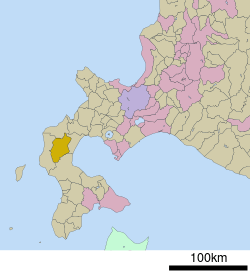Imakane, Hokkaido
Imakane (今金町, Imakane-chō) is a town located in Hiyama Subprefecture, Hokkaido, Japan.
Imakane 今金町 | |
|---|---|
Town | |
Imakane Town hall | |
 Flag  Emblem | |
 Location of Imakane in Hokkaido (Hiyama Subprefecture) | |
 Imakane Location in Japan | |
| Coordinates: 42°25′N 140°01′E | |
| Country | Japan |
| Region | Hokkaido |
| Prefecture | Hokkaido (Hiyama Subprefecture) |
| District | Setana |
| Government | |
| • Mayor | Hideto Sotozaki |
| Area | |
| • Total | 568.14 km2 (219.36 sq mi) |
| Population (September 30, 2016) | |
| • Total | 5,575 |
| • Density | 9.8/km2 (25/sq mi) |
| Symbols | |
| • Tree | Japanese Yew |
| • Flower | Tulip |
| Time zone | UTC+9 (JST) |
| Website | www |
As of September 2016, the town has an estimated population of 5,575 and a density of 9.8 persons per km². The total area is 568.14 km².
Geography
Imakane is located in southern Hokkaido within Setana District, Hiyama Subprefecture. The town is on Route 230 at the junction of the Shiribeshi-Toshibetsu and Toshibetsu-Mena rivers. The main landmark and meeting point in the town center is De Molen, a large windmill.
- Neighboring towns
- Mountains
- Mt. Kanikan (カ二カン岳, Kankan-dake) 981 m
- Rivers
- Shiribeshi-Toshibetsu River (後志利別川, Shiribeshi-Toshibetsu-gawa)
- Toshibetsu-Mena River
- Dams
- Pirika Dam (美利河ダム, Pirika-damu)
History
Imakane, at the time known as Hanaishi, was founded in the Kan'ei period between 1624 and 1643 after gold, silver and manganese were discovered in the upper Shiribetsu River, near Pirika/Hanaishi. Some of the gold mined from the area was used to build Nikkō Tōshō-gū, a Shinto shrine in Tochigi Prefecture dedicated to Tokugawa Ieyasu.
Agate was found in Hanaishi in 1877. Mining was started by Oshima Kanzaemon. Meanwhile, increasing numbers of people arrived in the area to mine existing seams of manganese, gold and silver and by the middle of the Meiji era many had settled in the Shiribetsu river area.
The town was granted independent status as the village of Toshibetsu and formed from the neighboring town of Setana in 1897. It was settled by Norioshi Shikata and 15 other families, including the Imamura and Kanamori houses. These families had arrived in the area during the preceding five years and laid out the town into 129 housing sites, a city hall and a police station.
Toshibetsu village formally received the name of Imakane in 1947 as part of its upgrade to town status. The name was taken from the family names of its two celebrated pioneers, Imamura (今村) and Kanamori (金森).
The town's constitution was established on October 1, 1967. Imakane celebrated its 100th year of autonomous government on July 15, 1997.
Immanuel Church
One of the attractions in rural Imakane is a very old church. In May 1881 Yoshiyuki Shikata and 10 other devout Christian students of the Doshisha University in Kyoto, settled in Imakane. They built a straw thatched church in March 1896 as their spiritual base and they worked hard on the land while leading a frugal religious life. In 1918 the church was rebuilt with wooden walls and again in November 1968 to its present-day state.
The name of the church is; Immanuel which means "God with us" in Hebrew. However, during the war years foreign words were strictly controlled by the government so they changed the name to "Imanueru" (今縫留) and the surrounding area to 神丘, meaning "God’s land" to preserve their religion. It was in this area around the church that Ginko Ogino, the first woman doctor in Japan, lived for a while. She had run her own hospital in Tokyo, but her second husband, Yoshiyuki Shikata, came to Hokkaido and settled in this area. She followed him, but the couple left a few years later. She was also the heroine in the novel “Hana-uzumi” written by Japanese writer Jun’ichi Watanabe, who used to be a doctor in Hokkaido.
Industry
Today Imakane's main industry is farming. Imakane is famous nationwide for potatoes, especially the Danshaku variety. Fishing is also widespread; yamame, ayu, unagi, and iwana can be found in the area.
Culture
Imakane has a number of festivals, including the Snow festival in mid February (usually the weekend after Sapporo's) and the Autumn Festival on September 19 and 20 every year.
Symbol of the Town
The symbol of Imakane comprises the meandering Toshibetsu River and the 1st letter of 農耕 (farming) which can be written in katakana as ノ and pronounced "no". This symbol was decided upon by a public competition on the town’s 70th anniversary (1967)
Another symbol of Imakane is a large windmill located in the center of town where the old train station stood. It is called "De Moren Imakane". The Name "De Moren" is Dutch for "windmill". In Spring the tulips come into bloom and is one of the symbols for Imakane.
Schools
Due to the steadily decreasing population, a number of schools have closed in recent years, including Yatsuka, Kinbara, Hanaishi and Kamioka elementary schools.
Imakane Junior High School has an exchange program with Burnside High School in Christchurch, New Zealand. Burnside High School students studying Japanese last visited Imakane in July 2016. Seven Imakane students visited Burnside High School in 2013. 2008 marked the 20th anniversary of the mutual exchange between the two groups, and Burnside Vice-Principal Mrs. Hume visited Imakane along with a number of students. Special events were held to mark the occasion, along with the signing of a Friendship agreement between Imakane and Burnside High School.
Notable people from Imakane
- Nobukazu Kuriki, mountaineer and entrepreneur
- Hiroshi Suzuki, bobsledder
- Chiyozakura Teruo, sumo wrestler
External links

- Official Website (in Japanese)